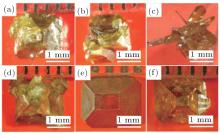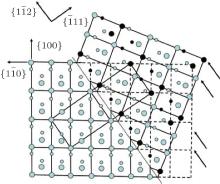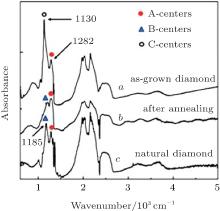†Corresponding author. E-mail: maha@jlu.edu.cn
*Project supported by the National Natural Science Foundation of China (Grant No. 51172089), the Natural Science Foundation of Guizhou Provincial Education Department, China (Grant No. KY [2013]183), and the Research Fund for the Doctoral Program of Tongren University, China (Grant Nos. DS1302 and trxyS1415).
In this paper, diamond crystallization from carbonyl nickel powders-C and carbonyl nickel powders+Fe–C systems are investigated in detail at a pressure of 6.0 GPa and temperatures ranging from 1410 °C–to 1435 °C by temperature gradient growth. The effects of Fe additive on the crystal morphology are discussed in the diamond crystallization process. Furthermore, Fourier infrared measurement results indicate that the spectrum of the diamond obtained from Ni + Fe–C system after annealing treatment is nearly consistent with that of natural diamond crystal. We believe that this study is of benefit to a further understanding of the growth mechanism of natural diamond.
The use of diamond has a long history because of its unique properties, such as physical, chemical, mechanical, and electrical properties.[1– 9] Since diamond was first synthesized using transition metals as a solvent in 1955, [10] a large number of investigations have been conducted to study the forming processes of the obtained diamond and the formation mechanism for natural diamond. The pressure and temperature (P– T) conditions of natural diamond growth are in the ranges of 900 ° C– 1200 ° C and 5.0 GPa– 7.0 GPa respectively. Lastly, it was reported that nano-polycrystalline diamond (NPD) was prepared through direct conversion by graphite. However, the synthetic pressure and temperature were more than 15.0 GPa and 2300 ° C.
The nitrogen impurity concentration in the form of C-centers (single substitutional nitrogen atoms) in diamond synthesized from a traditional catalyst is approximately in a range of 200 ppm– 400 ppm.[11– 14] The obtained diamond crystal is classically defined as type-Ib. The characteristics of this diamond are determined by the content and form of the nitrogen impurity. Since then, many studies have focused on diamond crystallization by using non-metallic catalyst.[15– 19] However, these diamond crystals always exhibit a twin-crystal or multicrystal structure, which is present even in synthesized diamond with a nitrogen concentration of up to 1000 ppm– 1500 ppm. Recently, many researchers have paid attention to the effects of minor elements on the synthesis of diamond crystallization.[20, 21] The effects of N and O atoms on the growth of the diamond film have been investigated, indicating that the quality of the diamond film was enhanced.[22] It is interesting to study the effects of the N and O atoms on the growth of the diamond under high pressure and high temperature (HPHT) conditions, especially diamond synthesized by temperature gradient growth. Furthermore, the formation of natural diamond takes place under HPHT conditions. Hence, it is a reasonable alternative to further understand the genesis of natural diamond.
Additionally, Fe is a main element in the earth crust and Fe element is also observed in natural diamonds in the so-called central inclusions — the zones of diamond crystal generation.[23] We believe that Fe probably plays a key role in the growth process of natural diamond. Considering the ancient age of most natural diamonds and the corresponding long post-growth period of their existence under high P– T parameters, it is interesting to perform experimental study on the simultaneous effects of N, O, and Fe elements on diamond crystallization under HPHT conditions.
Our experiments are divided into two stages: a series of experiments is carried out by employing carbonyl nickel powders as catalyst, and the rest are performed in carbonyl nickel powders with the addition of Fe. We believe that our experiments will provide valuable information for further understanding the genesis of natural diamond.
Experiments on diamond crystal growth by temperature gradient growth (TGG) were carried out using a china-type large volume cubic high-pressure apparatus (CHPA) (SPD-61 × 200). The temperature was calibrated by using a Pt6%Rh-Pt30%Rh thermocouple. Pressure was measured at room temperature by the change in resistance of standard substances and at working temperature by the graphite– diamond equilibrium. The {100} faces of high quality seed crystals were selected as growth facets. High-purity graphite powder (99.9% purity) was employed as a carbon source. After experiments, crystallization samples were dissolved in hot acids mixed with H2SO4 and HNO3 to remove the graphite and metal catalyst, which remained on the crystal surface. It should be noted that carbonyl nickel powders employed were the special nickel with 99.5 wt% in purity and a size of 3 μ m– 5 μ m in the experiments. The carbonyl nickel powders were obtained by decomposing Ni(CO)5 with a purity of 99.9 wt% in a stream of ammonia (NH3) in a running reactor under 300 ° C and 0.1 MPa conditions. Then, the carbonyl nickel powders were deoxidized under hydrogen for 1 h. Hence, the special nickel powders contained the nitrogen and oxygen impurities.
After the HPHT experiments, the diamond crystals and the carbonyl nickel powder were cleaned ultrasonically in anhydrous ethanol prior to the corresponding measurement. Then, the infrared spectra of the obtained diamond were measured by a Perkin– Elmer 2000 Fourier-transform infrared (FTIR) spectrometer in a spectral range between 400 cm− 1 and 4000 cm− 1 with a spectral resolution of 2 cm− 1 in transmittance mode at room temperature. Furthermore, carbonyl nickel powder catalyst was analyzed using x-ray diffraction (XRD) before and after HPHT experiments, and the XRD measurements with Cu– Kα (λ = 1.5418Å ) radiation were performed on an x-ray diffractometer (D/MAX-RA) in a range of 2θ from 20° to 80° .
Experiments on diamond crystallization in catalyst-C system are carried out at 6.0 GPa and temperature ranging from 1410 ° C to 1435 ° C with a duration of 8 h. The carbonyl nickel powder catalyst is analyzed by the typical x-ray diffraction pattern, which reveals that the carbonyl nickel powder catalyst is the dominant phase after the HPHT experiment, the results are shown in Fig. 1. This indicates that carbonyl nickel powders are suitable for diamond synthesis as a catalytic catalyst. The parameters and results of the experiments are listed in Table 1.
Figure 2 shows the optical images of the typical diamond crystals. It is clearly seen from Figs. 2(a) and 2(b) that the diamonds synthesized at temperatures of 1410 ° C and 1420 ° C primarily exhibit polycrystalline structures, and the typical {100} and {111} faces are still kept there. As the temperature increases up to 1435 ° C, the obtained diamond displays an irregular shape and the crystal is composed mainly of slices and strips, as shown in Fig. 2(c). However, the slices and strips are almost transparent and have a higher purity.
| Table 1. Experimental results on the crystallization of diamond in the carbonyl nickel powders-C and carbonyl nickel powders + Fe systems. |
Apparently, the growth habits for the synthesized diamonds are significantly affected with the addition content of Fe increasing in the catalyst. With 5-wt% Fe additive in the catalyst, the structure of the synthesized diamond is polycrystal and it has typical {111} faces. Furthermore, the obtained single diamond with 8-wt% Fe additive in the synthesis system exhibits an octahedral shape with dominated {111} and minor {100} faces, as shown in Fig. 2(e). But, the synthesized diamond crystal has the behavior of a twinned-crystal as the Fe additive increases to 15 wt%, which can be observed from Fig. 2(f). The regenerative crystal is usually produced from the {111} surface of the original crystal. In previous papers, strip-diamond could be obtained in the nitrogen-rich synthesis system under HPHT conditions. Those diamonds have elongated {100} and {111} crystal faces and they seem to be formed from the stretched cub-octahedron. It is probable that the formation of the strip diamond is attributed to the significant effect of nitrogen. Additionally, it is partly considered that the simultaneous incorporation of the nitrogen and oxygen atoms into the diamond lattices plays an important role in synthesizing the diamond slices.[24] Generally speaking, the growth habits of the synthesized diamond from conventional catalysts are mainly determined by the synthesis temperature at constant pressure and the morphology of the diamond changes from cubic via cub-octahedron to octahedral shape. However, the experimental results indicate that the morphology of the diamond is not only determined by the pressure and temperature but is also affected by the components of the catalyst. The change of the crystal shape resulting from the introduction of Fe element in the synthesis system could be explained as follows. The catalyst features of carbonyl nickel powders could be optimized when the appropriate amount of Fe element is introduced into the synthesis system, such as glutinosity, the liquid surface tension and the ability to dissolve graphite. Hence, the morphology of the obtained diamond transforms from polycrystal to single crystal with high-quality. As is well known, the growth mode of {111} surface of diamond belongs to two-dimensional (2D) growth layer by layer. However, the normal disposition and expansion of a new layer on {111} surface would be suppressed during diamond growth when a large amount of Fe is added into the synthesis system. Hence, the regenerative crystal is produced from the {111} surface of the original crystal.
It is interesting that the morphology of the synthesized diamond transforms from polycrystal to twinned-crystal via single diamond crystal as the content of Fe increases in the system. As shown in Fig. 2(f), it is observed that the derived crystal normally origins from the {111} face of the maternal diamond crystal. The experimental result could be partly explained as the following. As displayed in Fig. 3, although the interface of the twinned-crystal is {111} face, the crystal face of the regenerative crystal is not overlapped with any of the original crystal faces. However, the nearest relation of the atoms is still unchanged in the interface and the positions of one-third atoms in the regenerative crystal are identical with those of the C atoms before the formation of the twinned-crystal. Therefore, the interface is the twinned-crystal interface which has the lowest energy. Hence, Fe atoms play an important role in the diamond crystallization process and the content of the Fe additive should be strictly controlled.
The absorption spectra recorded for the diamonds are shown in Fig. 4. We can see from the spectra that the diamonds exhibit the peaks in the defect-induced one-phonon region (900 cm− 1– 1400 cm− 1) and strong absorptions caused by nitrogen impurity. We notice from curve a that nitrogen atoms mainly exist in the form of C-centers, which correspond to the absorption peaks at 1344 cm− 1 and 1130 cm− 1. It should be noted that the absorption of A-centers (pairs of nearest neighboring substitutional nitrogen atoms) is located at 1282 cm− 1, which is infrequent in diamonds synthesized from a conventional catalyst. The nitrogen concentration of the obtained diamond could be determined by the FTIR spectra and the value of nitrogen concentration could be quantitatively calculated as follows:[25, 26]


where NC, NA, and μ are the C-form nitrogen concentration, A-form nitrogen concentration, and the absorption intensity of the corresponding peak, respectively. The total value of the A-center and C-center defects is approximately 1200 ppm in the studied system. After the diamond is annealed at 1850 ° C, the characteristic absorptions at 1130 cm− 1 and 1344 cm− 1 corresponding to C-centers nitrogen defects nearly vanish and the intensity of absorption at 1282 cm− 1 is enhanced. At the same time, a B-center (a carbon vacancy surrounded by four nitrogen atoms substituting for carbon atoms) defect and the absorption at 1185 cm− 1 are noticed.[27] Therefore, this allows us to conclude that the substitutional nitrogen atoms tended to aggregate into A-center and B-center defects during the annealing.
From curve c in Fig. 4, the peaks at 1282 cm− 1 and 1185 cm− 1 are clearly observed, which correspond to A-center and B-center nitrogen atoms in natural diamond. Furthermore, the peaks at 1130 cm− 1 and 1344 cm− 1, relating to C-centers nitrogen, are not found. Compared with curves c and b, the infrared spectrum obtained from the synthesized diamond crystal after annealing is nearly consistent with that of IaA/B-type natural diamond. The difference is the weak absorption at 3107 cm− 1 due to hydrogen defects in natural diamond, [28] which is not observed in the synthesized crystals.
Diamond crystallizations from carbonyl nickel powders-C and Ni + Fe– C systems are investigated in detail by temperature gradient growth. The irregular shape of diamond synthesized from carbonyl nickel powders-C system could be effectively improved by appropriate addition of Fe element. The nitrogen concentrations of the obtained diamond crystals are 1200 ppm and A-center nitrogen atoms exist partly in the obtained diamond structures. The FTIR spectrum of the synthesized diamond after annealing treatment is almost consistent with that of natural diamond.
| 1 |
|
| 2 |
|
| 3 |
|
| 4 |
|
| 5 |
|
| 6 |
|
| 7 |
|
| 8 |
|
| 9 |
|
| 10 |
|
| 11 |
|
| 12 |
|
| 13 |
|
| 14 |
|
| 15 |
|
| 16 |
|
| 17 |
|
| 18 |
|
| 19 |
|
| 20 |
|
| 21 |
|
| 22 |
|
| 23 |
|
| 24 |
|
| 25 |
|
| 26 |
|
| 27 |
|
| 28 |
|






